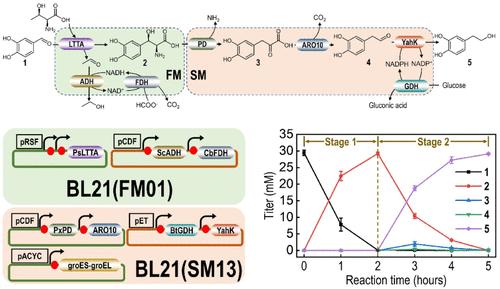当前位置:
X-MOL 学术
›
J. Agric. Food Chem.
›
论文详情
Our official English website, www.x-mol.net, welcomes your feedback! (Note: you will need to create a separate account there.)
Multienzymatic Cascade for Synthesis of Hydroxytyrosol via Two-Stage Biocatalysis
Journal of Agricultural and Food Chemistry ( IF 5.7 ) Pub Date : 2024-06-28 , DOI: 10.1021/acs.jafc.4c04228 Wen-Kai Liu 1, 2 , Bing-Mei Su 1, 2 , Xin-Qi Xu 1, 2 , Lian Xu 1, 2 , Juan Lin 1, 2
Journal of Agricultural and Food Chemistry ( IF 5.7 ) Pub Date : 2024-06-28 , DOI: 10.1021/acs.jafc.4c04228 Wen-Kai Liu 1, 2 , Bing-Mei Su 1, 2 , Xin-Qi Xu 1, 2 , Lian Xu 1, 2 , Juan Lin 1, 2
Affiliation

|
Hydroxytyrosol, a naturally occurring compound with antioxidant and antiviral activity, is widely applied in the cosmetic, food, and nutraceutical industries. The development of a biocatalytic approach for producing hydroxytyrosol from simple and readily accessible substrates remains a challenge. Here, we designed and implemented an effective biocatalytic cascade to obtain hydroxytyrosol from 3,4-dihydroxybenzaldehyde and l-threonine via a four-step enzymatic cascade composed of seven enzymes. To prevent cross-reactions and protein expression burden caused by multiple enzymes expressed in a single cell, the designed enzymatic cascade was divided into two modules and catalyzed in a stepwise manner. The first module (FM) assisted the assembly of 3,4-dihydroxybenzaldehyde and l-threonine into (2S,3R)-2-amino-3-(3,4-dihydroxyphenyl)-3-hydroxypropanoic acid, and the second module (SM) entailed converting (2S,3R)-2-amino-3-(3,4-dihydroxyphenyl)-3-hydroxypropanoic acid into hydroxytyrosol. Each module was cloned into Escherichia coli BL21 (DE3) and engineered in parallel by fine-tuning enzyme expression, resulting in two engineered whole-cell catalyst modules, BL21(FM01) and BL21(SM13), capable of converting 30 mM 3,4-dihydroxybenzaldehyde to 28.7 mM hydroxytyrosol with a high space–time yield (0.88 g/L/h). To summarize, the current study proposes a simple and effective approach for biosynthesizing hydroxytyrosol from low-cost substrates and thus has great potential for industrial applications.
中文翻译:

通过两阶段生物催化合成羟基酪醇的多酶级联
羟基酪醇是一种具有抗氧化和抗病毒活性的天然化合物,广泛应用于化妆品、食品和营养品行业。开发从简单且易于获得的底物生产羟基酪醇的生物催化方法仍然是一个挑战。在这里,我们设计并实施了一种有效的生物催化级联,通过由七种酶组成的四步酶级联从 3,4-二羟基苯甲醛和L-苏氨酸获得羟基酪醇。为了防止单个细胞中表达的多种酶引起的交叉反应和蛋白质表达负担,设计的酶级联被分为两个模块并以逐步的方式催化。第一个模块 (FM) 协助 3,4-二羟基苯甲醛和L-苏氨酸组装成 (2 S ,3 R )-2-氨基-3-(3,4-二羟基苯基)-3-羟基丙酸,第二个模块模块(SM)需要将( 2S , 3R )-2-氨基-3-(3,4-二羟基苯基)-3-羟基丙酸转化为羟基酪醇。每个模块都被克隆到大肠杆菌BL21 (DE3) 中,并通过微调酶表达进行并行工程改造,产生两个工程全细胞催化剂模块 BL21(FM01) 和 BL21(SM13),能够转化 30 mM 3,4 -二羟基苯甲醛转化为 28.7 mM 羟基酪醇,具有高时空产率 (0.88 g/L/h)。总而言之,本研究提出了一种简单有效的从低成本底物生物合成羟基酪醇的方法,因此具有巨大的工业应用潜力。
更新日期:2024-06-28
中文翻译:

通过两阶段生物催化合成羟基酪醇的多酶级联
羟基酪醇是一种具有抗氧化和抗病毒活性的天然化合物,广泛应用于化妆品、食品和营养品行业。开发从简单且易于获得的底物生产羟基酪醇的生物催化方法仍然是一个挑战。在这里,我们设计并实施了一种有效的生物催化级联,通过由七种酶组成的四步酶级联从 3,4-二羟基苯甲醛和L-苏氨酸获得羟基酪醇。为了防止单个细胞中表达的多种酶引起的交叉反应和蛋白质表达负担,设计的酶级联被分为两个模块并以逐步的方式催化。第一个模块 (FM) 协助 3,4-二羟基苯甲醛和L-苏氨酸组装成 (2 S ,3 R )-2-氨基-3-(3,4-二羟基苯基)-3-羟基丙酸,第二个模块模块(SM)需要将( 2S , 3R )-2-氨基-3-(3,4-二羟基苯基)-3-羟基丙酸转化为羟基酪醇。每个模块都被克隆到大肠杆菌BL21 (DE3) 中,并通过微调酶表达进行并行工程改造,产生两个工程全细胞催化剂模块 BL21(FM01) 和 BL21(SM13),能够转化 30 mM 3,4 -二羟基苯甲醛转化为 28.7 mM 羟基酪醇,具有高时空产率 (0.88 g/L/h)。总而言之,本研究提出了一种简单有效的从低成本底物生物合成羟基酪醇的方法,因此具有巨大的工业应用潜力。
















































 京公网安备 11010802027423号
京公网安备 11010802027423号